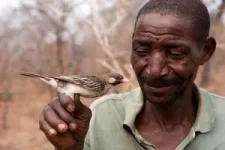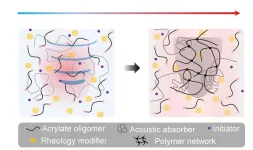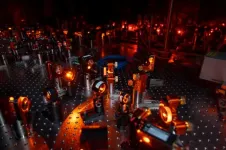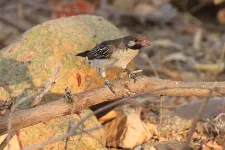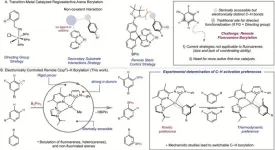(Press-News.org) In many parts of Africa, humans cooperate with a species of wax-eating bird called the greater honeyguide, Indicator indicator, which leads them to wild bees’ nests with a chattering call. By using specialised sounds to communicate with each other, both species can significantly increase their chances of accessing calorie-dense honey and beeswax.
Human honey-hunters in different parts of Africa use different calls to communicate with honeyguides. In a new study, researchers have discovered that honeyguide birds in Tanzania and Mozambique discriminate among honey-hunters’ calls, responding much more readily to local than to foreign calls.
“We found that honeyguides prefer the calls given by their local human partners, compared to foreign calls and arbitrary human sounds. This benefits both species, since it helps honey-hunters attract a honeyguide to show them hard-to-find bees’ nests, and helps honeyguides to choose a good partner to help them to get at the wax,” said Dr Claire Spottiswoode, an evolutionary biologist at the University of Cambridge’s Department of Zoology and the University of Cape Town, and joint lead author of the paper.
Hadza honey-hunters in Tanzania communicate with honeyguides using a melodic whistle, whereas Yao honey-hunters in Mozambique use a trill followed by a grunt.
The experiments showed that honeyguides in the Kidero Hills, Tanzania are over three times more likely to cooperate with people giving the local Hadza whistle, than people giving the ‘foreign’ Yao trill and grunt. And the honeyguides in the Niassa Special Reserve, Mozambique are almost twice as likely to cooperate in response to the local Yao trill and grunt, than the ‘foreign’ Hadza whistle.
The phenomenon seems to be self-reinforcing: honeyguides learn to recognise that a specific call indicates a good honey-hunting partner, and humans are more successful in attracting the birds if they use this call.
People who use a different call are less likely to attract a bird to guide them to the honey – so it’s in their interests to stick to the sounds used locally.
“Once these local cultural traditions are established, it pays for everyone – birds and humans – to conform to them, even if the sounds themselves are arbitrary,” said joint lead author Dr Brian Wood, an anthropologist at the University of California, Los Angeles.
The researchers compare this to different human languages, in which the sounds of words are arbitrary, but everyone has agreed on their meaning.
Spottiswoode added: “Just as humans across the world communicate using a range of different local languages, people across Africa communicate with honeyguide birds using a range of different local sounds.”
Like language, these culturally determined calls convey an underlying meaning – signalling a desire to partner with the bird to find honey.
The study is published today in the journal Science.
It is likely that cultural factors relating to the wider hunting practices of different groups have helped to shape the precise design of their honey-hunting calls.
For example, the melodic whistle made by Hadza honey-hunters in Tanzania to attract honeyguide birds sounds like a bird call. This reduces the risk of frightening away the prey animals they’re trying to hunt at the same time.
In contrast, the loud trill followed by a grunt made by Yao honey-hunters in Mozambique, sounds distinctively human. This may be a good way for them to frighten away dangerous large animals like elephants and buffalo.
The findings build on work published in 2016, which found that honeyguide birds in Mozambique respond to the calls of human honey hunters.
The researchers work closely with the Yao and Hadza honey-hunting communities in Africa, whose guidance they have relied on for over a decade.
“It’s such a privilege to witness cooperation between people and honeyguides – these are birds who specifically come to seek us out. The calls really sound like a conversation between the bird and the honey-hunters, as they move together towards a bees’ nest,” said Spottiswoode.
Humans are useful collaborators to honeyguides because of our ability to subdue stinging bees with smoke and chop open the nest, providing wax for the honeyguide and honey for ourselves.
This relationship is a rare example of cooperation between humans and wild animals. Wild honey is a high-energy food that can provide up to 20% of the calorie intake for honey-hunters – and the wax they share or discard is a valuable food for the honeyguide.
“What’s remarkable about the honeyguide-human relationship is that it involves free-living wild animals whose interactions with humans have evolved through natural selection, possibly over the course of hundreds of thousands of years,” said Spottiswoode.
She added: “This ancient, evolved behaviour has then been refined to local cultural traditions – the different human call sounds – through learning.”
The research is a collaboration between researchers at the University of Cambridge, the University of Cape Town, and the University of California Los Angeles, and many honey hunters who inspired and supported the experiments.
END
Grunt or whistle: successful honey-hunters know how to communicate with wild honey-seeking birds
2023-12-07
ELSE PRESS RELEASES FROM THIS DATE:
Geoscientists map changes in atmospheric CO2 over past 66 million years
2023-12-07
Embargoed: Not for Release Until 2:00 pm U.S. Eastern Time Thursday, Dec. 7 2023.
Today atmospheric carbon dioxide is at its highest level in at least several million years thanks to widespread combustion of fossil fuels by humans over the past couple centuries.
But where does 419 parts per million (ppm)—the current concentration of the greenhouse gas in the atmosphere—fit in Earth’s history?
That’s a question an international community of scientists, featuring key contributions by University of Utah geologists, is sorting out by examining a plethora of markers in the geologic record that offer ...
Ancient stars made extraordinarily heavy elements
2023-12-07
How heavy can an element be? An international team of researchers has found that ancient stars were capable of producing elements with atomic masses greater than 260, heavier than any element on the periodic table found naturally on Earth. The finding deepens our understanding of element formation in stars.
We are, literally, made of star stuff. Stars are element factories, where elements constantly fuse or break apart to create other lighter or heavier elements. When we refer to light or heavy elements, we’re talking about their atomic mass. Broadly speaking, atomic ...
Soundwaves harden 3D-printed treatments in deep tissues
2023-12-07
DURHAM, N.C. -- Engineers at Duke University and Harvard Medical School have developed a bio-compatible ink that solidifies into different 3D shapes and structures by absorbing ultrasound waves. Because it responds to sound waves rather than light, the ink can be used in deep tissues for biomedical purposes ranging from bone healing to heart valve repair.
This work appears on December 7 in the journal Science.
The uses for 3D-printing tools are ever increasing. Printers create prototypes of medical devices, design flexible, ...
Physicists ‘entangle’ individual molecules for the first time, hastening possibilities for quantum information processing
2023-12-07
For the first time, a team of Princeton physicists have been able to link together individual molecules into special states that are quantum mechanically “entangled.” In these bizarre states, the molecules remain correlated with each other—and can interact simultaneously—even if they are miles apart, or indeed, even if they occupy opposite ends of the universe. This research was recently published in the journal Science.
“This is a breakthrough in the world of molecules because of the fundamental importance of quantum entanglement,” said Lawrence Cheuk, assistant professor of physics at Princeton ...
Wild birds lead people to honey — and learn from them
2023-12-07
Key takeaways
People in parts of Africa communicate with a wild bird, the greater honeyguide, to locate bee colonies and harvest their honey and beeswax.
A study by UCLA anthropologist Brian Wood and other authors show how this partnership is maintained and varies across cultures.
They demonstrate the bird’s ability to learn distinct vocal signals traditionally used by different honey-hunting communities.
In parts of Africa, people communicate with a wild bird — the greater honeyguide — in order to locate bee colonies and harvest their stores of honey and beeswax.
It’s a rare example of ...
Evolving trends in cosmetic breast augmentation: New data
2023-12-07
November 30, 2023 – Ongoing quality improvement data submitted by Board-certified plastic surgeons highlight current trends in surgical technique in cosmetic breast augmentation using implants, reports a study in the December issue of Plastic and Reconstructive Surgery®, the official medical journal of the American Society of Plastic Surgeons (ASPS). The journal is published in the Lippincott portfolio by Wolters Kluwer.
"The findings illustrate evolving trends in breast enhancement over the past 16 years, including factors like the location of the incision and the type and positioning of implants," comments lead author Michael J. Stein, ...
Princeton Chemistry develops catalyst for electronically controlled C–H functionalization
2023-12-07
The Chirik Group at the Princeton Department of Chemistry is chipping away at one of the great challenges of metal-catalyzed C–H functionalization with a new method that uses a cobalt catalyst to differentiate between bonds in fluoroarenes, functionalizing them based on their intrinsic electronic properties.
In a paper published this week in Science, researchers show they are able to bypass the need for steric control and directing groups to induce cobalt-catalyzed borylation that is meta-selective.
The lab’s research ...
Llama power: Tiny llama nanobodies neutralize different noroviruses. Can they improve human anti-viral therapies?
2023-12-07
Human noroviruses cause acute gastroenteritis, a global health problem for which there are no vaccines or antiviral drugs. Although most healthy patients recover completely from the infection, norovirus can be life-threatening in infants, the elderly and people with underlying diseases. Estimates indicate that human noroviruses cause approximately 684 million illnesses and 212,000 deaths annually.
“Human noroviruses are highly diverse,” said first author Dr. Wilhelm Salmen, a graduate student in Dr. B V Venkataram Prasad’s lab while he was working ...
Less ice on the road leads to more salt in the soil, air, and water
2023-12-07
When temperatures drop and roads get slick, rock salt is an important safety precaution used by individuals, businesses, and local and state governments to keep walkers, cyclists, and drivers safe. However, according to a new scientific review paper from a team of researchers at Virginia Tech and the University of Maryland, the human demand for salt comes at a cost to the environment.
Published in the journal Nature Reviews Earth & Environment with researchers Stanley Grant, Megan Rippy, and Shantanu Bhide from Virginia Tech’s Occoquan Watershed Monitoring Laboratory, ...
Very early treatment of newborns with HIV could result in medication-free remission for many babies
2023-12-07
An unexpectedly high percentage of children, who were born with HIV and started treatment within 48 hours of life, exhibit biomarkers by 2 years of age that may make them eligible to test for medication-free remission, according to a multinational study published in Lancet HIV.
“Moving away from reliance on daily antiretroviral therapy (ART) to control HIV would be a huge improvement to the quality of life of these children,” said Protocol Co-Chair and senior author Ellen Chadwick, MD, former Director of Section ...


